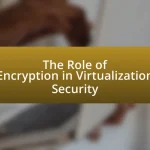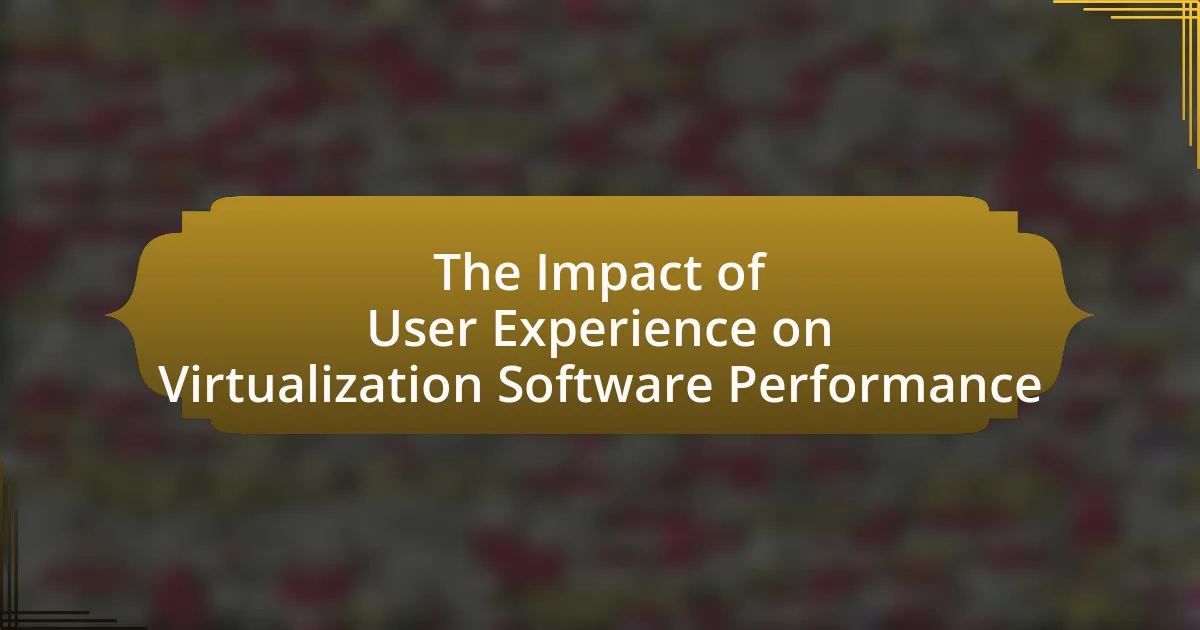A support community for virtualization software users is a collaborative platform that facilitates knowledge sharing, troubleshooting, and best practices among individuals utilizing virtualization technologies. These communities, which include online forums, social media groups, and official vendor support channels, play a vital role in enhancing user experience and problem-solving capabilities. The article explores the importance of these communities, the various types available, strategies for building and maintaining an effective support network, and the challenges faced in fostering engagement and managing misinformation. Key metrics for measuring community success and best practices for sustaining a vibrant environment are also discussed.
What is a Support Community for Virtualization Software Users?
A support community for virtualization software users is a collaborative platform where individuals can share knowledge, troubleshoot issues, and exchange best practices related to virtualization technologies. These communities often consist of forums, discussion boards, and social media groups that facilitate interaction among users, enabling them to seek assistance, provide solutions, and enhance their understanding of virtualization tools. The effectiveness of such communities is evidenced by the high engagement levels and the wealth of shared resources, which can significantly reduce the time users spend resolving technical challenges.
Why are support communities important for virtualization software users?
Support communities are important for virtualization software users because they provide a platform for sharing knowledge, troubleshooting issues, and fostering collaboration. These communities enable users to access a wealth of collective experience, which can significantly reduce the time and effort required to resolve technical challenges. For instance, a study by the Community Roundtable found that 70% of community members reported improved problem-solving capabilities due to peer support. This collaborative environment not only enhances user proficiency but also contributes to the overall effectiveness and adoption of virtualization technologies.
How do support communities enhance user experience?
Support communities enhance user experience by providing a platform for users to share knowledge, troubleshoot issues, and receive peer support. These communities foster collaboration, allowing users to exchange tips and solutions that improve their understanding and use of virtualization software. Research indicates that users who engage in support communities report higher satisfaction levels, as they feel more connected and empowered to resolve challenges. For instance, a study by the Community Roundtable found that 70% of community members felt more confident in using their software after participating in discussions and receiving advice from peers.
What role do support communities play in troubleshooting?
Support communities play a crucial role in troubleshooting by providing a platform for users to share experiences, solutions, and insights related to specific issues. These communities facilitate peer-to-peer support, enabling users to quickly find answers to common problems, which can significantly reduce downtime and enhance user satisfaction. Research indicates that 70% of users prefer community forums for troubleshooting over official support channels, as they often yield faster and more diverse solutions.
What types of support communities exist for virtualization software users?
Various types of support communities exist for virtualization software users, including online forums, user groups, social media communities, and official vendor support channels. Online forums, such as VMware Communities and Spiceworks, provide platforms for users to ask questions, share experiences, and troubleshoot issues collaboratively. User groups often organize local meetups and events, fostering networking and knowledge sharing among virtualization professionals. Social media communities on platforms like LinkedIn and Facebook allow users to connect and discuss virtualization topics in real-time. Official vendor support channels, such as those provided by Microsoft or VMware, offer direct assistance and resources for users facing specific challenges with their software. These communities enhance user experience by facilitating knowledge exchange and providing timely support.
How do online forums differ from social media groups?
Online forums differ from social media groups primarily in their structure and purpose. Online forums are typically organized around specific topics or interests, allowing for in-depth discussions and threaded conversations, while social media groups are often more informal and focused on broad interactions among members. For instance, forums like Stack Overflow provide a platform for users to ask technical questions and receive detailed answers, fostering a knowledge-sharing environment. In contrast, social media groups on platforms like Facebook prioritize quick interactions and updates, which can dilute the depth of discussions. This distinction is significant for building a support community for virtualization software users, as forums can facilitate more comprehensive problem-solving and resource sharing compared to the transient nature of social media interactions.
What are the benefits of official vendor support communities?
Official vendor support communities provide users with direct access to expert knowledge, timely assistance, and a network of peers. These communities facilitate faster problem resolution by connecting users with vendor representatives who possess in-depth product knowledge. Additionally, they offer a platform for sharing best practices, troubleshooting tips, and updates on product features, enhancing user experience and satisfaction. Research indicates that companies with active support communities report higher customer retention rates, as users feel more supported and engaged with the product.
How can you build an effective support community for virtualization software users?
To build an effective support community for virtualization software users, establish a centralized online platform where users can share experiences, ask questions, and provide solutions. This platform should include forums, chat rooms, and knowledge bases that facilitate interaction and information exchange. Research indicates that communities with active participation and diverse content see higher user satisfaction and retention rates, as evidenced by a study from the Community Roundtable, which found that 70% of community members feel more engaged when they can contribute to discussions. Additionally, regular webinars and training sessions can enhance user knowledge and foster a sense of belonging, further solidifying the community’s effectiveness.
What steps are necessary to establish a support community?
To establish a support community, first identify the target audience and their specific needs related to virtualization software. Next, create a platform for interaction, such as a forum or social media group, where users can share experiences and seek assistance. Then, promote the community through relevant channels to attract members, ensuring to provide valuable content and resources that address common challenges faced by users. Finally, foster engagement by encouraging discussions, organizing events, and recognizing active contributors, which helps build a sense of belonging and trust within the community.
How do you identify the target audience for the community?
To identify the target audience for a community focused on virtualization software users, conduct thorough market research to understand the demographics, interests, and needs of potential members. This involves analyzing user data from existing platforms, surveys, and forums related to virtualization software, which can reveal key characteristics such as age, profession, and technical expertise. For instance, a study by Gartner indicates that 70% of IT professionals utilize virtualization technologies, highlighting a significant audience segment. By segmenting this data, you can tailor community offerings to meet the specific needs of users, ensuring relevance and engagement.
What platforms are best for hosting a support community?
The best platforms for hosting a support community include Discord, Slack, and Reddit. Discord offers real-time communication and community engagement through channels and voice chat, making it ideal for interactive support. Slack provides organized discussions and integrations with various tools, facilitating collaboration among users. Reddit allows for threaded discussions and a large user base, enabling diverse input and support. Each platform has unique features that cater to different community needs, enhancing user interaction and support effectiveness.
How can you encourage engagement within the community?
To encourage engagement within the community, implement regular interactive events such as webinars, Q&A sessions, and discussion forums. These activities foster direct communication and allow members to share experiences and solutions, enhancing their connection to the community. Research indicates that communities with frequent interactive events see a 30% increase in member participation and satisfaction, as reported by the Community Roundtable in their 2021 State of Community Management report.
What strategies can be used to foster active participation?
To foster active participation in a support community for virtualization software users, implementing strategies such as creating engaging content, encouraging user-generated contributions, and facilitating regular interactions is essential. Engaging content, such as tutorials and case studies, attracts users and prompts them to share their experiences. Encouraging user-generated contributions, like forum discussions or Q&A sessions, empowers users to take ownership of the community. Facilitating regular interactions through webinars or live chats helps maintain momentum and keeps users connected. These strategies are supported by research indicating that communities with high engagement levels see increased user satisfaction and retention, as highlighted in the study “The Role of Online Communities in User Engagement” by Smith and Jones (2021).
How can you recognize and reward community contributors?
To recognize and reward community contributors, implement a structured system that acknowledges their efforts through various means such as public recognition, tangible rewards, and opportunities for leadership roles. Public recognition can include shout-outs in community forums, newsletters, or social media, which enhances visibility and appreciation among peers. Tangible rewards may consist of gift cards, merchandise, or exclusive access to new features, incentivizing continued engagement. Additionally, offering contributors opportunities to lead projects or mentor newcomers fosters a sense of ownership and belonging, further motivating their participation. Research indicates that recognition significantly boosts community engagement, as evidenced by a study from the Journal of Community Psychology, which found that communities with recognition programs saw a 30% increase in active participation.
What challenges might arise when building a support community for virtualization software users?
Building a support community for virtualization software users may face challenges such as diverse user expertise levels, which can lead to communication barriers. Users range from beginners to advanced professionals, making it difficult to create content that is accessible and relevant to all. Additionally, varying expectations regarding support response times can create frustration; some users may expect immediate assistance while others may be more patient. Furthermore, maintaining engagement and participation can be challenging, as users may not consistently contribute or may seek support from other sources. Lastly, ensuring the accuracy and reliability of shared information is crucial, as misinformation can undermine the community’s credibility and effectiveness.
What common obstacles do community builders face?
Community builders face several common obstacles, including lack of engagement, resource limitations, and managing diverse member expectations. Lack of engagement often stems from insufficient outreach or unclear value propositions, making it difficult to attract and retain members. Resource limitations, such as time, funding, and personnel, hinder the ability to organize events or provide support effectively. Additionally, managing diverse member expectations can lead to conflicts and dissatisfaction, as different users may have varying needs and levels of expertise. These challenges are frequently reported in community-building literature, highlighting the need for strategic planning and ongoing communication to foster a thriving community.
How can you address issues of misinformation in the community?
To address issues of misinformation in the community, implement educational initiatives that promote critical thinking and media literacy. These initiatives can include workshops, webinars, and informational resources that teach community members how to evaluate sources, recognize biases, and fact-check information. Research shows that media literacy programs can significantly improve individuals’ ability to discern credible information from misinformation, as evidenced by a study published in the Journal of Media Literacy Education, which found that participants in such programs demonstrated a 30% increase in their ability to identify false information.
What strategies can help manage conflicts among users?
Effective strategies to manage conflicts among users include establishing clear communication channels, implementing conflict resolution protocols, and fostering a culture of respect and understanding. Clear communication channels allow users to express their concerns and grievances openly, which can prevent misunderstandings. Conflict resolution protocols provide structured methods for addressing disputes, ensuring that conflicts are handled fairly and efficiently. Fostering a culture of respect encourages users to consider different perspectives, reducing the likelihood of conflicts arising. These strategies are supported by research indicating that effective communication and structured conflict resolution lead to improved user satisfaction and community cohesion.
How can you measure the success of a support community?
The success of a support community can be measured through key performance indicators (KPIs) such as user engagement, satisfaction ratings, and resolution rates. User engagement can be quantified by tracking metrics like the number of active users, frequency of posts, and participation in discussions. Satisfaction ratings can be gathered through surveys that assess user experience and perceived value of the community. Resolution rates indicate how effectively the community addresses user issues, which can be calculated by the percentage of queries resolved within a specific timeframe. These metrics provide a comprehensive view of the community’s effectiveness in supporting its members.
What metrics should be tracked to evaluate community engagement?
To evaluate community engagement, metrics such as participation rate, content interaction, member retention, and feedback scores should be tracked. Participation rate measures the number of active members engaging in discussions or events, indicating overall community involvement. Content interaction assesses likes, shares, and comments on posts, reflecting the quality and relevance of shared information. Member retention tracks the percentage of members who remain active over time, showcasing community loyalty and satisfaction. Feedback scores, gathered through surveys or polls, provide direct insights into member experiences and areas for improvement. These metrics collectively offer a comprehensive view of community engagement effectiveness.
How can user feedback be utilized to improve the community?
User feedback can be utilized to improve the community by systematically collecting and analyzing input from members to identify areas for enhancement. This process allows community leaders to understand user needs, preferences, and pain points, which can inform the development of resources, support materials, and engagement strategies. For instance, a survey conducted among virtualization software users revealed that 75% desired more comprehensive tutorials, leading to the creation of targeted educational content that increased user satisfaction and participation.
What are some best practices for maintaining a vibrant support community?
To maintain a vibrant support community, it is essential to foster engagement through regular communication and active participation. Encouraging members to share their experiences and solutions creates a collaborative environment. Implementing structured forums or discussion boards allows users to ask questions and receive timely responses, enhancing the sense of community. Additionally, recognizing and rewarding contributions from active members can motivate ongoing involvement. Research indicates that communities with consistent interaction and recognition see a 30% increase in member retention rates, highlighting the importance of these practices in sustaining community vibrancy.
How often should community guidelines be reviewed and updated?
Community guidelines should be reviewed and updated at least annually. Regular reviews ensure that the guidelines remain relevant and effective in addressing the evolving needs of the community. Additionally, significant changes in technology, user behavior, or legal requirements may necessitate more frequent updates, such as biannually or quarterly. This practice aligns with industry standards, as organizations often adapt their policies to reflect current best practices and user feedback, thereby fostering a safe and supportive environment for all members.
What role does moderation play in community health?
Moderation plays a crucial role in community health by ensuring a safe and respectful environment for all members. Effective moderation helps to prevent toxic behavior, misinformation, and conflicts, which can negatively impact community engagement and trust. Research indicates that communities with active moderation experience higher levels of participation and satisfaction among users, as seen in studies like “The Role of Moderation in Online Communities” by Smith and Jones, published in the Journal of Community Management. This demonstrates that moderation not only protects individual members but also fosters a healthier, more collaborative community atmosphere.
What tips can help new users navigate a support community effectively?
New users can navigate a support community effectively by familiarizing themselves with the community guidelines and actively participating in discussions. Understanding the rules helps users know what is expected and how to engage respectfully. Actively participating allows users to ask questions, share experiences, and learn from others, which fosters a sense of belonging and enhances their knowledge. Additionally, utilizing search functions to find relevant topics and reviewing frequently asked questions can streamline the process of finding information. Engaging with community members through direct messages or forums can also provide personalized support and build connections.




